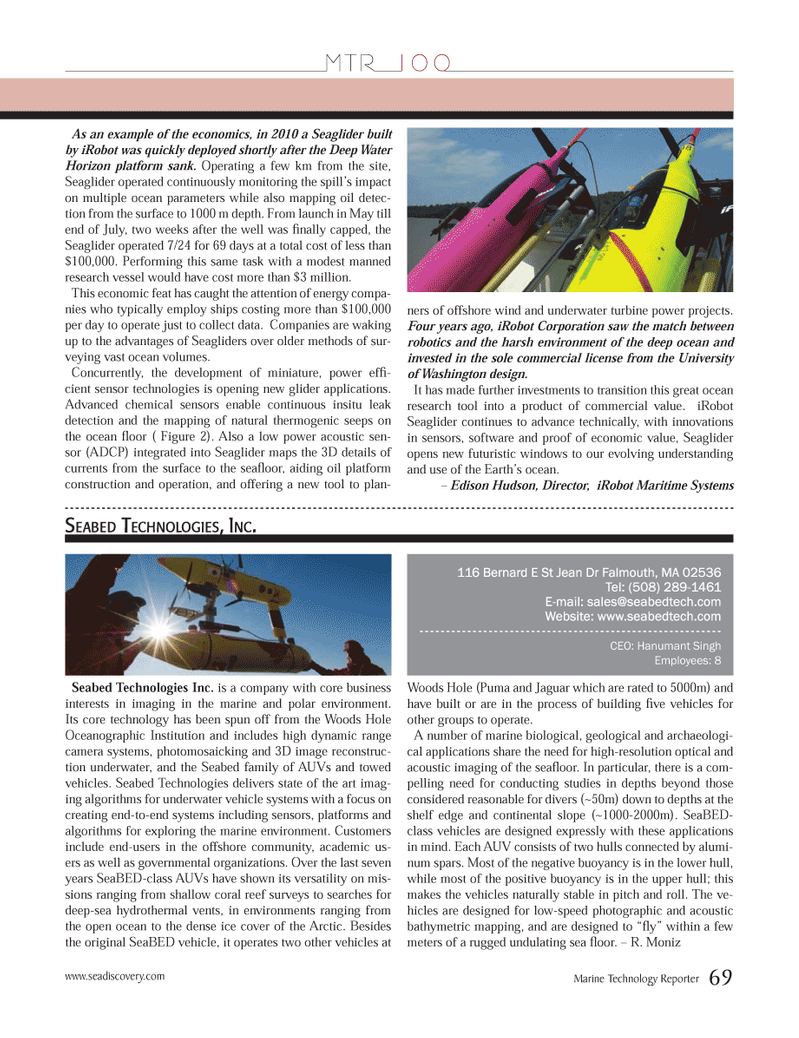
Page 69: of Marine Technology Magazine (July 2012)
MTR 100
Read this page in Pdf, Flash or Html5 edition of July 2012 Marine Technology Magazine
As an example of the economics, in 2010 a Seaglider built by iRobot was quickly deployed shortly after the Deep Water Horizon platform sank. Operating a few km from the site, Seaglider operated continuously monitoring the spill?s impact on multiple ocean parameters while also mapping oil detec-tion from the surface to 1000 m depth. From launch in May till end of July, two weeks after the well was nally capped, the Seaglider operated 7/24 for 69 days at a total cost of less than $100,000. Performing this same task with a modest manned research vessel would have cost more than $3 million. This economic feat has caught the attention of energy compa- nies who typically employ ships costing more than $100,000 per day to operate just to collect data. Companies are waking up to the advantages of Seagliders over older methods of sur- veying vast ocean volumes. Concurrently, the development of miniature, power ef -cient sensor technologies is opening new glider applications. Advanced chemical sensors enable continuous insitu leak detection and the mapping of natural thermogenic seeps on the ocean oor ( Figure 2). Also a low power acoustic sen- sor (ADCP) integrated into Seaglider maps the 3D details of currents from the surface to the sea oor, aiding oil platform construction and operation, and offering a new tool to plan- ners of offshore wind and underwater turbine power projects. Four years ago, iRobot Corporation saw the match between robotics and the harsh environment of the deep ocean and invested in the sole commercial license from the University of Washington design. It has made further investments to transition this great ocean research tool into a product of commercial value. iRobot Seaglider continues to advance technically, with innovations in sensors, software and proof of economic value, Seaglider opens new futuristic windows to our evolving understanding and use of the Earth?s ocean. ? Edison Hudson, Director, iRobot Maritime Systems Seabed Technologies Inc. is a company with core business interests in imaging in the marine and polar environment. Its core technology has been spun off from the Woods Hole Oceanographic Institution and includes high dynamic range camera systems, photomosaicking and 3D image reconstruc-tion underwater, and the Seabed family of AUVs and towed vehicles. Seabed Technologies delivers state of the art imag- ing algorithms for underwater vehicle systems with a focus on creating end-to-end systems including sensors, platforms and algorithms for exploring the marine environment. Customers include end-users in the offshore community, academic us- ers as well as governmental organizations. Over the last seven years SeaBED-class AUVs have shown its versatility on mis- sions ranging from shallow coral reef surveys to searches for deep-sea hydrothermal vents, in environments ranging from the open ocean to the dense ice cover of the Arctic. Besides the original SeaBED vehicle, it operates two other vehicles at Woods Hole (Puma and Jaguar which are rated to 5000m) and have built or are in the process of building ve vehicles for other groups to operate.A number of marine biological, geological and archaeologi-cal applications share the need for high-resolution optical and acoustic imaging of the sea oor. In particular, there is a com- pelling need for conducting studies in depths beyond those considered reasonable for divers (~50m) down to depths at the shelf edge and continental slope (~1000-2000m). SeaBED-class vehicles are designed expressly with these applications in mind. Each AUV consists of two hulls connected by alumi- num spars. Most of the negative buoyancy is in the lower hull, while most of the positive buoyancy is in the upper hull; this makes the vehicles naturally stable in pitch and roll. The ve- hicles are designed for low-speed photographic and acoustic bathymetric mapping, and are designed to ? y? within a few meters of a rugged undulating sea oor. ? R. Moniz SEABED TECHNOLOGIES , INC.SEABED TECHNOLOGIES , INC.116 Bernard E St Jean Dr Falmouth, MA 02536 116 Bernard E St Jean Dr Falmouth, MA 02536 Tel: (508) 289-1461 Tel: (508) 289-1461 E-mail: [email protected] E-mail: [email protected] Website: www.seabedtech.com Website: www.seabedtech.com CEO: Hanumant Singh Employees: 8 www.seadiscovery.com Marine Technology Reporter 69MTR #6 (66-80).indd 69MTR #6 (66-80).indd 698/3/2012 9:59:12 AM8/3/2012 9:59:12 AM

 68
68

 70
70
